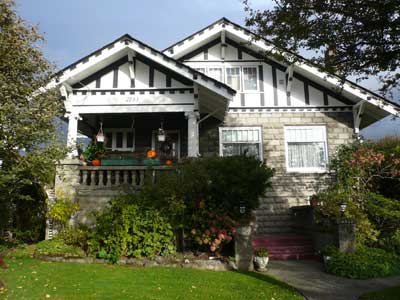ARCHITECTURE:
This is an unusual house for Victoria – fewer than 12 are known – built of moulded concrete block, or hydro-stone as it is called in the east, where it was the material used to rebuild the huge section of Halifax destroyed by the 1917 munitions ship explosion. Only the gables of this house are not block, but stucco and half-timbering above a dentilled wooden string course, echoed by angled dentils on the bargeboards. The foundation and main floor walls are composed of at least eight different patterns of block, including the water table and belt course, and a decorative string course which runs around the house below the windows. The corner front porch has both balusters and fluted Ionic columns of concrete block, making this one of our most elaborate concrete block houses.
ORIGINAL OCCUPANTS:
A.W. Beal took out a building permit in July 1913, and plumbing permit in September, but the house is not listed in the 1914 city directory, nor is A.W. Beal. He also built 2619 Blackwood in 1910. The 1915-16 owner, according to assessments, is John Henry Moore, likely the John H. Moore who was vice-president of Canadian Puget Sound Lumber Co. The Cuthbertson family and descendants have owned the house since 1917, and understood that Beal went broke and couldn’t finish the house; this is very possible, as 1913-14 were bust years after the boom of 1907-12. Lewis Cuthbertson completed construction after they moved in.
Lewis (1874-1945) had married Margaret Theresa “Maggie” Jones (1884-1950) at her family home at 1116 Fort St, Victoria, in 1911. Maggie was the daughter of James McNab Jones (1848-1918) from Ireland and Fanny Moore (1855-1934) from England, who married in Ottawa, ON, in the 1870s, lived in Winnipeg, MN, in the 1880s, and came to Victoria in 1889. James had fought in the Fenian Raids in 1863 and 1869, with the Canadian boatmen in the Nile Expedition of 1884-85, and worked as a building painter, and real estate salesman during the pre-WWI boom, and as a fruit grower in Gordon Head. By 1912, the Jones family had moved to 2616 Blackwood, a block below this house, where daughters Belle (1877-1958) and Nell (1893-1984) lived into the late 1960s.
When Maggie married Lewis, she was a dressmaker and he, born in Bristol, Quebec, was a logger/faller and resident of Blaine, WA. Lewis hurt his back logging, and became a lumber inspector. They had four children; youngest daughter Kathleen Mary “Kaye” (1924-1988) stayed at home and later inherited the house with brother Herbert, who lived in Vancouver. Kaye trained at Sprott Shaw College after high school, courtesy of her aunt Belle Jones, and worked as a telephone operator with BC Electric then BC Tel until her marriage in 1956 to Peter Kalojanoff (1919-2004), who changed his family’s name to Kalonoff the next year. After their marriage, they bought out Herbert’s share of the house.
Peter was born in Bulgaria and trained as a tailor, then became a border guard in the Bulgarian army. He then went to a training school in Weimar and got his certificate as a master tailor. At some point he was in the German army, fought against the Russians, and got shrapnel in his leg. He ended up in a Russian concentration camp. He escaped the Communists then spent time in a Displaced Persons Camp. In 1950 he was sent to Canada under a resettlement scheme, spent time in Montreal and Edmonton, and eventually crossed the country to Victoria. He bought 1012 Government St and founded Esquire Tailors in the 1950s and K-Fashions in the 1970s, retiring in 1983. Peter and Kaye had two daughters, but Liea died about 1990. Ann married Steve Thomson in 1982, and they moved back into the house in 1988, shortly after Ann’s mother died.
ADDITIONAL INFORMATION & IMAGES:
• Map of Victoria Heritage Register Properties


Recent Comments